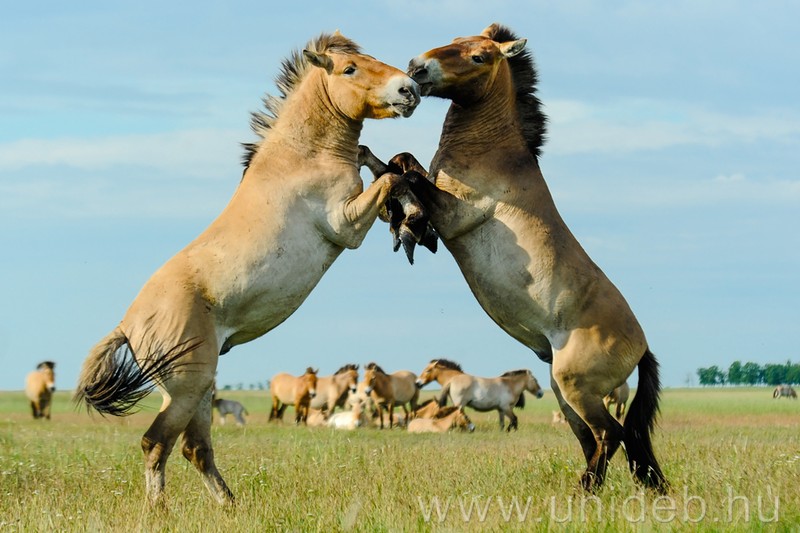Hungarian researchers, including specialists from the University of Debrecen, studied the complex, multi-segmented society of wild horses and its changes with the help of high-resolution aerial photographs in a recently completed multi-year research. The results of the tests were recently published in the prestigious international scientific journal Nature Communications.
The researchers used a drone to follow the movement of the complex Przewalski stud, made up of harems, living in the Pentezug reserve in Hortobágy. A study published in the journal Nature Communications highlights that, by collecting high-resolution data, even a few minutes of footage of animal movements can provide enough information to learn about the social structure of the population, and even draw conclusions about the past and future dynamics of the group.
Observing about three hundred animals at the same time is by no means an easy task. We used drones to take aerial videos of the stud while they were moving in the reserve, and based on the recordings we determined the movement routes of all the individuals of the stud with high spatial and temporal resolution
– explained Katalin Ozogány, researcher at the University of Debrecen, first author of the study, HUN-REN- Member of the DE (formerly ELKH-DE) Behavioral Ecology Research Group.
The analysis of the movement yielded surprising results for the researchers as well.
The individuals of the group coordinate their movements and align with each other, and by demonstrating these subtle interactions, it became clear that we can learn about the social network of the stud based on the collective movement
– explained lead author Máté Nagy, head of the MTA-ELTE Group Behavior ‘Lendület’ research group.
The researchers compared the short movement observations of a few minutes with the population observation data of the national park going back two decades. Since the establishment of the reserve, the wild horses have been uniquely recognized by the park workers and regularly collect data on population changes.
Thanks to population monitoring, we know the lineage of the animals, which we also confirm with genetic sampling, as well as their place in the social system, that is, we regularly record which individual belongs to which harem
– said co-author Viola Kerekes, head of the Hortobágy National Park Directorate’s wildlife project.
The analysis showed that the social relations of wild horses are related to kinship and previous acquaintances of the animals. For example, mares are closer to mares with whom they have been harem mates for a long time in the social network. Kinship can play a significant role in the organization of harems into studs since the harems of sibling studs are closer to each other in the social network than those of unrelated studs. At the same time, the migration of mares between closer harems was demonstrably greater, which also contributes to the relations between harems through familiarity.
It is an exceptional opportunity to explore the social network of an entire population and its dynamics
– explained co-author Attila Fülöp, a researcher at the University of Debrecen, Babeş-Bolyai University and HUN-REN-DE (formerly ELKH-DE) Behavioral Ecology Research Group.
It turned out that harems that have existed for a long time and have more members, which typically belong to older, more experienced studs, occupy a more central place in the stud’s social network. One of the possible explanations for this is that the harem bulls form an alliance in order to protect their harems more effectively against the bachelor stallions. Movement analysis also allowed us to deduce which mares would leave their harems and which ones they would move to in the next two years.
One of the surprising turns of the investigation is that we can infer future group dynamics by observing the current movement. The researchers showed that those mares that lived in other harems at the time of the aerial photographs but became harem mates two years after the photographing, were already moving in a more similar trajectory than the other mares at the time the photograph was taken
– added Zoltán Barta, lead author, Debrecen Head of the University’s Department of Evolutionary Zoology and the Behavioral Ecology Research Group of HUN-REN-DE (formerly ELKH-DE).
A study written by researchers from the University of Debrecen, Eötvös Loránd University and Hortobágy National Park Administration (Fine-scale collective movements reveal present, past and future dynamics of a multilevel society in Przewalski’s horses. Katalin Ozogány, Viola Kerekes, Attila Fülöp, Zoltán Barta & Máté Nagy) was published on September 5 in the journal Nature Communications. A short video of the study is available at this link.
(unideb.hu)


















